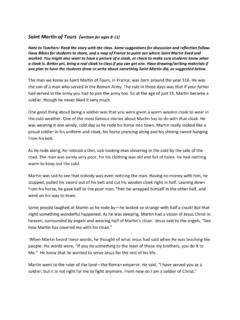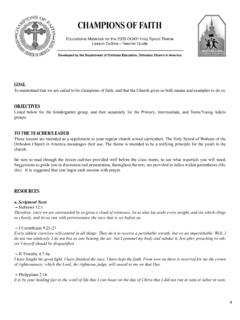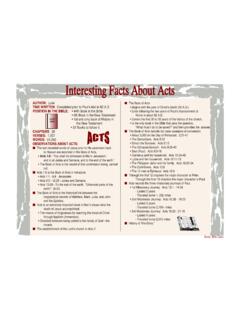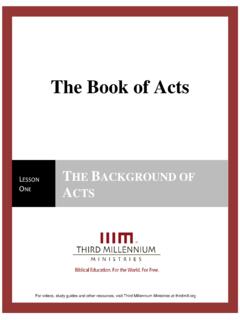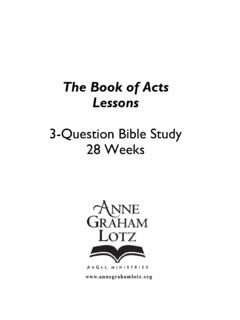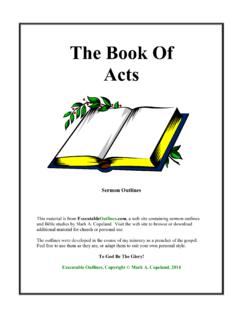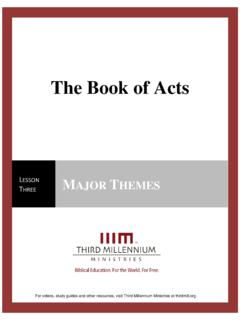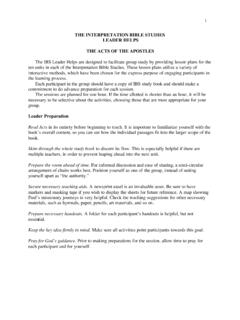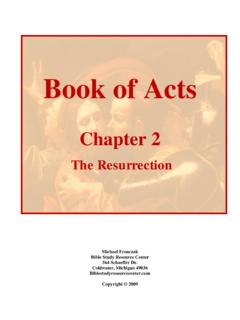Transcription of Activities for the Book of Acts - Orthodox Church …
1 1 Activities for the book of acts Three sets of Activities based on the book of acts , created by the Department of Christian Education of the Orthodox Church in America To the Teacher: Here are sets of 3 Activities for 3 age groups: Grades 4-6, 7-8 and 9-12. These are approximate age groupings, so feel free to use the Activities as you deem appropriate for your particular group of students. The Activities are intended as seasonal supplements to your regular Church school curriculum, but it would be fine to use them at any time of year.
2 During the month of May the Church s daily readings include most of the book of acts , so the Activities are partly based on that book . Students will also learn about Saint Pachomius of Egypt, whose feast day is May 15th, and older students will consider some of the wonderful stories of spiritual courage from the books about Father Arseny, the priest and prisoner who as a prisoner in Soviet work camps saved the lives and sanity of many fellow prisoners and others in the camps. The Activities compare his experiences with those of the apostles in acts . Each session begins with an introductory page that will give you information needed to complete the Activities , followed by pages for the students, which you can copy and distribute.
3 As with previous materials produced by the Department of Christian Education, we have used the Revised Standard Version of the Bible for its relatively clear wording. Reference is also made to the Orthodox Study Bible, which uses the Septuagint version. We haven t included prayers to begin and end sessions. If you are using these lessons as stand-alones rather than add-ons to your Sunday teaching, use whatever prayers you wish. The first activity for each age group is the story of Saint Pachomius, written simply for younger students and with a little more detail for the older ones, and followed by age-appropriate questions or reflections.
4 We hope you and your students will enjoy and benefit from using these Activities as supplements to your Church school sessions in the days of spring or any time you choose. The Activities for the 3 grade level groupings are on the following pages: Grades 4-6 pages 1 to 10 Grades 7-8 pages 11-19 Grades 9-12 pages 20-29 Department of Christian Education, Orthodox Church in America 2 Grades 4-6: Activity #1 (Please be sure to read To the Teacher, general introduction on page 1) Saint Pachomius: Introduction for the Teacher The story of this Egyptian saint, who lived in the early 4th century, can be attractive to children because they sometimes disagree with siblings and friends, as Pachomius brother John disagreed with him about building his first monastery.
5 It also shows what one person can do. Be sure students understand that a monk is a person who lives a life of prayer, fasting and service away from the busy life of society. Materials needed: Copies of the story (on the following page) for each student, Bibles for each student or to share. Procedure: Give students copies of the story. Read it together, and then ask these review questions: 1. Saint Pachomius name in the Coptic language is Pachom. What does it mean? (Eagle) 2. How did Pachomius first meet Christians? (As a member of the Roman Army, when Christians visited and ministered to soldiers) 3.
6 What did Pachomius do when his time as a soldier was finished? (He was baptized, because he wanted to be a Christian like the kind people he had met while a soldier) 4. What did an angel tell Pachomius to do? (Build a monastery) 5. Why did Pachomius brother disagree with his plan to build a monastery? (His brother John thought that men would not come into the desert to live as monks) Next, have students open their Bibles to acts 27. Before reading from the Bible together, tell students: In acts 27 Saint Paul was on a ship sailing to Rome. The ship had stopped at a harbor called Fair Havens.
7 Paul urged the captain to wait a while before starting back on the sea voyage. An angel had told Paul a big storm was brewing at sea. But the captain wouldn t listen, and they started out on the voyage. Sure enough, a bad storm hit the ship. The crew threw all the food and cargo into the sea to keep the ship from sinking. Read together 27: 21-26. Ask students: What experience did Saint Paul and Saint Pachomius both have? (They were told to do something important by an angel of the Lord, but other people didn t want them to do what the angel had said they should.)
8 Ask, Do people ever disagree with us when we try to do what God wants us to do? Ask for examples. Things like not taking part when someone is being made fun of; not sneaking around with friends to do something everyone s parents have put off-limits; going to Church instead of going on a fun outing with friends, might be examples. (end) 3 Grades 4-6 Saint Pachomius of Egypt (pronounced Pa ko mee-us) When Saint Pachomius was a young boy growing up in Egypt, he didn t know anything about God. He had never heard of Jesus Christ. His family and all the people they knew worshipped many gods but not the one true God.
9 His name in the Coptic language of his native country means eagle. Pachomius and many of his friends were ordered to join the Roman Army. As soldiers they were crowded together in a cold, bare building. Their food was cheap and not very tasty or filling. Each day was full of hard work that wore them out by evening. They missed their homes. But this hard life was made easier by a group of visitors who came often. They brought good food and things to drink. They gave each soldier kind smiles and hopeful words. Who are these people? Pachomius wondered. When he learned that they were Christians, he decided he would become a Christian after he got out of the army.
10 He was sure that the God who taught people to care so much for strangers must be the only real God. When his army service ended, Pachomius was baptized. He went to the desert and spent years with a monk there, learning to pray and to serve God. Then he became a monk. His brother John joined him in the desert. One day an angel appeared to Pachomius, telling him to build a monastery. His brother saw no reason to do it. He said, We are out in the desert. Who is going to come here and live in this big place you want to build? Don t do something so foolish! But Pachomius did as the angel had told him, and soon men began coming to join the monastery.
